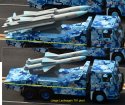And you need to look back to my previous post, where I describe the same arrangement for YJ-12s air intakes, where the air intake does not extend along the entire air intake external structure. Different ways of saying the same thing
That is to say, for all the missiles listed (YJ-12, XASM-3, Kh-31 and Kh-41), they all feature air intakes which converge together in the centre of the missile projectile itself to provide for the ramjet combustion chamber, however all of them also seemingly has extended air intake structures that leads to their nozzles.
The point that I'm making in all their cases, is that what appears to be air intake structures which go all the way to their nozzles, are not actually the entire air intake, and that the air intakes/ducts themselves converge at the combustion chamber in the missile projectile.
I'm very bemused that you're holding this opinion about YJ-12, because even if we ignore the lesser known, older and more well known missiles such as Kh-31 (first picture below shows MA-31 drone variant of Kh-31) and Kh-41 (second picture below) have the same air intake/duct configuration.
If you still really cannot comprehend how the air intakes of these missiles work, then I'll use another picture to demonstrate. It is essentially the same as this missile, the 2K12 Kub, which depicts the missile's air intakes converging joining with the missile projectile, but the external air intake structure also "stops" where the actual air intake itself converges into the missile projectile. In the case of YJ-12, Kh-31, Kh-41, XASM-3, the external air intake structure "continues" to the aft of the missile near the nozzle, however the actual air intake/duct is no longer part of the structure at that point.









